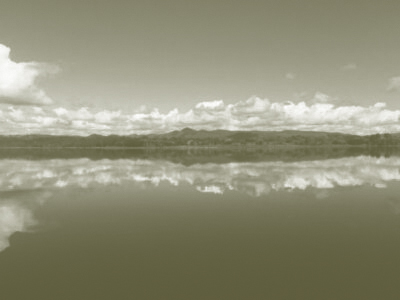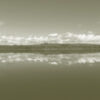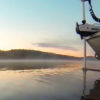OVERVIEW OF THE VESSEL PERMIT SCHEME
Permit-holders will be issued a key to access the Seqwater Land Licenced Area, a permit card and a vessel identification sticker. Only the operator of the craft is required to be a permit holder. Other persons accompanying a permit-holder are the responsibility of the permit holder and must remain in the immediate company of the permit holder at all times. A single vessel permit holder is permitted to bring one vessel (and as many crew as specified by the visible capacity label) onto the Land Licenced Area and the Lake Access Area. Family permit holders may bring vessels sufficient to comply with the Family permit as per their application and its acceptance by the PRFMA.
The types of vessels permitted under the scheme are canoes, kayaks and small boats that are either electrically or manually powered. Vessels fitted with internal combustion engines (inboard or outboard engines) are not permitted on the Land Licenced Area and the Lake Access Area. Internal combustion engines must be completely removed from the access vessel. Vessels must be safe and seaworthy and must be fitted with safety equipment as specified by the relevant Queensland Transport Operations (Marine Safety) Regulations. Paddle Boards are not permitted
Prior to being granted a permit, each applicant will be required to agree to abide by the – “Rules of Permit”
THE LAKE
From the boat ramp at Boral landing on Adsetts Road we have roughly 6 kilometres upstream and 5 kilometres downstream. When leaving the boat ramp you head south out of the back water and into the lake main stream. By turning right or to the west this takes you in the direction of Dayboro or the top of the lake. If you turn left when you head out into the main stream this will take you down towards McGavin’s View or the dam wall. Refer to your Lake Samsonvale Map which you received when you picked up your PRFMA permit, for other points of interest.
WATERCRAFT
The choice is yours, small boats maximum 5 metres in length. (Tinnies, Kayaks and Canoes) powered exclusively by means of electric motors or through the use of oars or other manual means on the North Pine River arm of Lake Samsonvale (the Lake Access Area) for the purpose of recreational fishing. Paddle Boards are not permitted.
POWER
Pedal, paddle, sail or electric, it is necessary to know your limits, it’s a long way down or upstream to the boundary markers. It’s no good pedaling, paddling or powering to the far boundary if you do not have the power or personal stamina to return. If relying on power it is always a good idea to carry a spare battery. It is advisable to carry a mobile phone with you as well as your PRFMA card with emergency numbers which is compulsory.
SOUNDER
A decent entry sounder is advisable if you are serious about tracking down fish. This also shows you the depth you are fishing in and any underwater structures etc. These days a sounder with a good pixel count of 480×480 is reasonably priced.
TYPES OF FISH AVAILABLE
Australian bass, golden perch, silver perch, saratoga, mary river cod, spangled perch, garfish, eel tail catfish, eels, tilapia and red claw crayfish.
FISHING AND READING THE LAKE
Use the sounder to read the lake, learn where the drop-offs are, the underwater structures, these can be standing trees, fallen trees, logs, large rocks, bridges, roads, fences, mounds, creek beds, underwater points. In fact get to know the fish’s underwater paradise because these above areas are the types of places the fish hide out. If you do not have a sounder it is all guess work.
TYPES OF FISHING
FLY
This has been successful for a small amount of avid fly fisher people. Things to try are:<
- Surface fly
Early AM or dusk, cast between the dead trees, next to the lily pads or to the gaps or along the edges of weed beds when they are available. Use poppers and gurglers. Etc - Subsurface Intermediate.
Early AM or dusk cast to the bank or weed edge. Let sink a little, then slow strip a few feet, let it sink again and repeat. Use mud eye patterns and sub surface water pushers. Etc - Sinking Fly
Best used to schooling fish suspended or on the bottom. Cast, count down to required depth and retrieve through school. Strip jerk, strip jerk or whatever works on the day. Use bass vampires and crazy charlies and fish patterns. Etc
BAIT FISHING
Bait gathering on the lake must be as per DPI and PRFMA rules and regulations. There are several types of bait that can be used. They include worms and grasshoppers but the best seems to be local freshwater shrimp. With shrimp traps please use a bit of commonsense when placing them around the dam. Keep them out of recognised trolling lanes, don’t leave many metres of loose rope attached to float that is not needed, don’t interfere with other people’s traps and don’t use traps with openings that turtles or diving birds can get caught in. When using shrimp for bait make sure you change water regularly especially in summer.
RIGS FOR BAIT FISHING
Any of the bream rigs will work okay. Floating sinker, sinker above swivel, or best is a type of paternoster rig. Sinker on bottom 50 cm line, hook, 25cm line and then swivel. This allows you when trolling and using snaps to unhook lure and put on bait rig quickly. Good hooks to use are the wide gape hooks as they seem to hook up around the outside of the fish’s mouth more so than smaller hooks which can do a lot of damage when halfway down a fish’s throat. Floating shrimp is another good way to fish, simply just attach a hook to the end of your line then attach a shrimp, cast and let the weight of the shrimp slowly float down.
Couple of hints when using bait:
- Make sure after smoking, applying sunscreen, eating oranges etc etc give your hands a wipe with a wet cloth, as sometimes the smell can turn the fish off the bite.
- Also if using paternoster rig, remove the long claws off the shrimp as they tend to hang onto the line and not move about to attract the fish’s attention.
- Quick release rod holders are also a good idea when using bait, as opposed to the lock in model. Sometimes a fish can be lost while trying to get the rod out of the holder.
RODS AND REELS
Rods and reels are a personal choice. However when deciding which to use remember a light rod is better to detect the slightest bite, but is much harder when fighting the fish. A stiffer tipped rod is easier when fighting the fish but you may not see the lighter bites. Try both till you find what suits you. Reels are also a personal choice. Either bait caster rods and reels or spin rods and reels. When choosing a line keep in mind that too light a line is useless if you hook into a yellow belly or fork tail catfish or even a decent size bass. On the other hand too heavy a line will scare fish away so a good starting point is about 10 to 15 lbs braid with a 10 to 15 leader.
LURE FISHING
Lure fishing involves, trolling, jigging, casting and covers plastics, spinner baits, bibles rattlers, hardbodies, surface, metal slugs, jigs and blades etc etc.
Plastics
Plastics include paddle tail grubs, single tail grubs and triple tail grubs, shads, stick baits, flick baits and minnows etc (These are usually fitted to jig heads and cast, let sink to required depth and hopped or jigged back to the boat)
Spinner baits
Range in style and size from 1/8 ounce to the 2 ounce models. Stinger hooks can be added and also soft plastics can be added to the stinger hooks. Spinner baits are a good searching lure as they are less likely to snag up. They can be trolled or used for cast and retrieve.
Bibless Rattlers or Non Rattlers
These include Jackals, Megabass, Rattletraps, G Vibes and Spros etc. They can be trolled or cast and hopped off the bottom or through a school.
Hardbodies
Include small minnows, long skinny minnows, short fat minnows, and large fish shape shads. The size of the bib on these lures and body shape usually depicts the depth it travels at. Also the length of line out from the boat when trolling. Smaller hardbodies like Atomic Hardz, Jackall Chubbies etc can be cast to the bank and retrieved.
Surface Lures
These include many types and shapes, paddlers, crawlers, stick baits, poppers, fizzers, and insect patterns, walk the dog style lures and many more. These are usually cast as close to the bank as possible and slowly retrieved. With some of these lures you have to jiggle or jerk the rod tip to get the action you require from the lure. Surface lures are also very good around lily pads or weed beds.
Metal Slugs and Jigs
These can be cast, let sink and either hopped along the bottom or through a suspended school, or vertically jigged up and down under the boat when holding over a school.
Blades
There are many brands and types on the market at the moment. They range in size from 1/12 ounce up to several ounces. These can be cast, let sink to the required depth then slow or fast retrieve back to the boat. They can be hopped along the bottom and also stop jerked along in whatever depth the fish are sitting at. Sometimes a little jerk of the rod is required to get the lure vibrating on the start of the retrieve.
Types of Lure Fishing
Trolling Lures
One of the more common forms of lure fishing is trolling. When doing this use the knowledge gained by reading your sounder. Troll along the creek lines, over drop offs, over the top of under water hill tops, across points or spur lines, along the edges of steep banks and weed beds. Trolling with your lures just above the thermocline and trolling just above the under water trees is also an advantage. These are all the places where the fish hang out, so the closer you can get your lures into the strike zones the better. When trolling the best way to know your lake is to take a different track each time you set out. Learn where your creek beds are, these areas become very important when the water levels drop. Trolling is a good way of covering ground and searching for those elusive schools. When located you can troll over the school or stop and try other styles of fishing.
Trolling depths depends on the size of lure and the size of bib, rule of thumb, big bib dives deeper than small bib. If you need to get a small bib lure down deeper when trolling then you need to use a down rigger or a paravane or let out more line behind the boat.
Trolling Lures Include. Hard bodied minnows, bibles rattlers, Tazi Devils, spinner baits Etc
Casting Lures
Main use of casting lures is casting to the bank. This covers casting to steep banks and hopping your lure down through the water column. Also casting to underwater points, dropoffs and creek beds and hopping or slow rolling your lure back This is where the fish like to hide or the path they take when moving about. Casting to suspended schools in midwater and slow rolling your lure through them. Casting to the gaps in between or along weed beds, or casting to lily pads, dead trees, logs Etc
Casting lures include just about every lure available. Surface style lures, plastics, blades, slugs, hard bodies, spinner bait etc. Pick your casting lure by what depth you require it to go down to, what speed you are going to retrieve it at, how much action and noise you want it to have and what colour is working on the day.
Lure Colours
Without going into a lengthy debate on what colour lures to use on North Pine Dam, general opinion from many reports and fishing magazines are that dark days dark lures, light days light lures, dirty water dark or bright contrasting colours, clear water light or natural colours. Rule of thumb start early am with darker coloured lures and go lighter as the sun rises in the sky, then go darker later in the afternoon. A bit of trial and error is needed here to see what is working on the day.
Weather Conditions
Wind, rain, barometer, sun and overcast conditions play a part in a successful days fishing.
Wind
Fishing is not usually as good when there is no wind at all (glassed out). A slight breeze is okay as it puts a ripple on the water, which gives the fish security from above when in shallow water. It is also an advantage when bait fishing as it makes the boat yaw from side to side when anchored up, which in turn keeps the bait moving around. It also helps for a slow drift when casting or bait fishing. Only use for a strong breeze is if you have the wind behind you. It can help you get distance when you cast your line.
Rain
A pending storm is a good time to fish, as long as it is not an electrical storm. This usually coincides with a rising barometer. Rainy conditions are usually okay for the first couple of days of rain and then the fish seem to go off the bite.
Barometer
Old saying 1020 Bass Aplenty. This is not always the case but it is another of the contributing factors. Usually a rising barometer is okay and a falling one seems to put the fish off the bite.
Sun
Fish seem to be a lot more active in the low light hours, early am and late afternoon, they seem to feed and attack lures early am and then as the sun gets higher in the sky they slow down, and then get more active in the afternoon. These times are also good times for surface lures.
Overcast
Overcast days can be rewarding also as fish seem to come up higher in the water column, overcast days and early am, late pm are good times to hit all the shallow back waters as sometimes the fish tend to move into these areas when there is low light.
Summary
When choosing the type of fishing you wish to do, remember to try to match your lures or bait the food source available for fish in the lake. These include shrimp, baby crayfish, bony bream, tilapia, small minnows and gudgeons, small elves, insects and worms from freshly covered banks when the waters rise.
Author – Dennis Pearce



